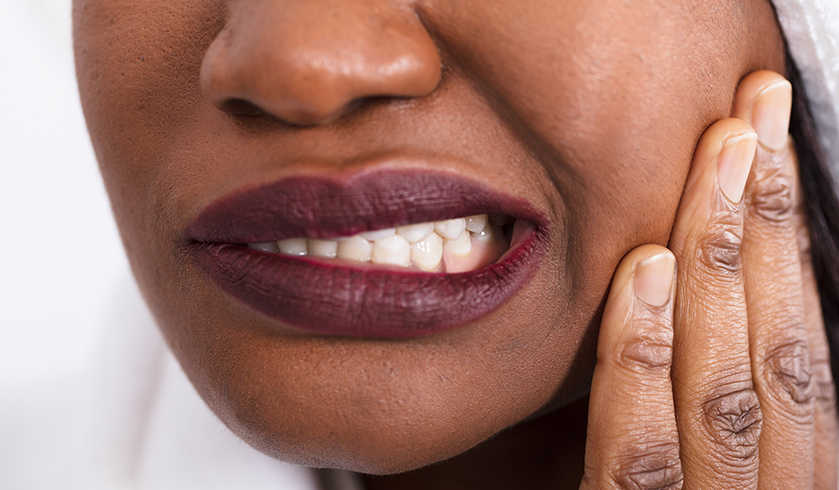Emergency dentists often treat children and adults who suffer from toothache and severe tooth pain. The toothache and the pain may arise for many reasons that only a professional dentist can identify and recommend treatment for.
Toothache and pain can often be prevented by treating the underlying cause. Attending regular six-month appointments enable dentists to evaluate the patient’s oral health condition and treat dental and gum disorders before they cause toothache and oral pain.

What may cause toothache?
The toothache is a sign of an inflammation of the dental pulp. The dental pulp is a delicate tissue structure inside the tooth that contains the blood vessels and sensitive nerves. There are several reasons a dental pulp can become inflamed including:
- Broken or loose fillings;
- A cracked tooth
- Tooth decay;
- Receding gums;
- Bacterial infection.
Other reasons to experience a toothache that doesn’t involve dental pulp infection can include:
- Impacted wisdom teeth;
- The eruption of wisdom teeth;
- Ulcers on the gums;
- Injury to the temporomandibular joint (the joint that connects the skull to the jaw);
- Sinus inflammation.
Accessing Dental Care for Toothache
Our clinic provides timely appointments throughout the week for toothache and pain. Get in touch with us by phone or email and we can arrange an appointment with a clinician to assess your oral health.
Get in touchThe symptoms of a toothache may be temporarily treated through an emergency dental kit while an emergency dentist is contacted for treatment. These temporary measures should not be used as long-term solutions, nor should painkillers be repetitively used as a professional dental treatment replacement.
Some dentists do not have long waiting lists, and immediate dental care can be provided through fast-tracked appointments, mainly where the individual is an existing patient. Having a toothache treated early can prevent severe tooth pain, further dental trauma, and a dental emergency.
The dentist first assesses the oral condition and the cause of the toothache. Pain may be experienced throughout the jaw and face. Therefore, diagnostic screening tests are necessary to locate the source of pain. The type of treatment recommended will depend on the cause of the pain.
The following treatments may be used for the treatment of toothache:
- Professional teeth cleaning;
- Dental fillings, inlays and onlays to fill tooth cavities;
- Night mouthguards to prevent teeth grinding;
- Proper cleaning of orthodontic devices and dentures;
- Composite white filler or dental crowns;
- Orthodontic braces to correct teeth misalignment;
- Gum regeneration and contouring to treat gum recession;
- Root canal treatment to remove infection;
- Tooth extraction to prevent the spread of infection;
- Tooth restorations to restore damaged teeth;
- Dental implants to replace missing tooth roots;
- Crowns, bridges and dentures to replace missing teeth;
- Home dental hygiene may not remove all plaque and tartar build-up that harms tooth structure. Therefore, professional dental cleaning is best sought to remove debris from areas between teeth where the toothbrush and floss cannot reach. Similarly, properly cleaning dental and orthodontic devices can prevent plaque and bacteria from developing in the mouth.
Amalgam metal fillings are replaced by tooth-coloured white composite fillings for an improvement in aesthetics. White fillings can restore tooth structure, shape and colour. Veneers and Lumineers may be used to cover teeth for a more natural, white and symmetrical teeth appearance.
Dental crowns are made from various materials such as ceramics, porcelain, resin, gold, and zirconium. These materials are durable and serve as natural-looking teeth for healthy chewing function.
Orthodontic braces are the primary means of aligning mild to severe tooth structural conditions for proper bite function and improved facial expression. There is a range of modern dental braces to choose from, and these are designed to be near-invisible and prevent the stigma associated with traditional metal braces.
Root canal treatment is provided to remove painful infections, prevent the spread of the infection and save the tooth where possible. However, if a tooth extraction is necessary artificial teeth, replacement options are available to choose from, including dental implants, crowns, bridges and dentures.
Ultimately, dentists provide guidance on preventing tooth decay and tooth damage so individuals may have a reduced risk of suffering toothache and not go through extensive and costly dental treatment. When pain in the tooth arises it is better to get early dental treatment or emergency dental care to prevent the condition from worsening.
The risk of experiencing toothache can be reduced by timely dental care and good oral hygiene practice. Preventing the causes of tooth pain means the individual can lower the likelihood of experiencing pain and needing emergency care. Steps that should be followed to reduce the risk of toothache include:
- Maintaining oral hygiene to prevent tooth decay;
- Consuming a healthy balanced diet, exercising, moderating alcohol intake and not smoking;
- Having professional teeth cleaning;
- Attending regular dental appointments to monitor oral health;
- Seeking immediate dental care for oral trauma, toothache and other dental concerns;
- Wearing a mouthguard to prevent teeth grinding or a sports mouthguard from warding off an oral injury;
- Having orthodontic braces and dentures, professionally repaired when broken;
- Not using temporary dental repair kits long term.
Although these steps may lower the risk of getting a toothache, other actions need to be followed to immediately treat pain before receiving emergency, or professional dental care is received. These steps can include:
- Place an ice-pack over the area of the face where the pain is experienced to reduce it and prevent swelling;
- Use painkillers as advised through the manufacturer leaflet;
- Apply clove oil to an infected tooth with some cotton wool;
- Temporarily fill a cavity with some sugar-free gum or dental wax or cement from an emergency dental repair kit;
- Apply teeth desensitising gel to the tooth surface.
